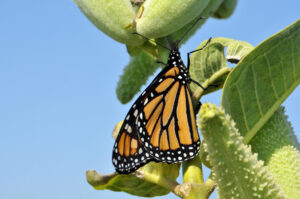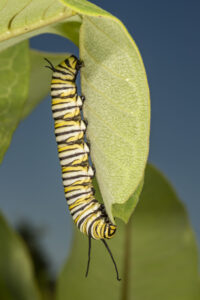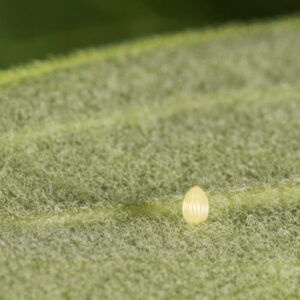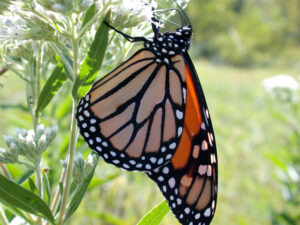Throughout Indiana, the characteristic flashes of orange and black wings that announce the arrival of the monarch butterfly have largely been missing. Within their native range, monarch butterfly populations have declined steeply since the 1990s, landing them on the International Union for Conservation of Nature (IUCN) Red List of Threatened Species this year. Much of their decline is due to loss of habitat and host plants coupled with increased herbicide and insecticide use. Climate change can also wreak havoc on monarchs since they require adequate moisture and a narrow range of temperatures to thrive.
- Figure 1. Monarch butterfly on common milkweed. Photo by John Obermeyer, Purdue Extension Entomology.
- Figure 2. Monarch caterpillar feeding on milkweed leaf. Photo by John Obermeyer Purdue Extension Entomology
Monarch caterpillars must feed on milkweed, Asclepias spp. (Asclepiadaceae), to grow into adult butterflies. As they eat leaves, stems, and seed pods, they store toxins that help them survive. As adults, those toxins make them unpalatable and protect them from predators. Monarch caterpillars’ reliance on milkweed as their sole food source puts monarchs at increased risk of population decline. In the Hoosier state, much of the native grassland, which would have supported vast numbers of milkweed plants, has been converted to agriculture. Broad-spectrum insecticides and herbicides may further reduce monarch numbers. Without adequate access to milkweed free of insecticide drift, monarchs’ numbers drop.
Furthermore, Indiana’s spring to summer breeding season was unusually dry this year, with areas receiving only approximately 50% of the expected rain between March and August. Late spring cold snaps and summer heatwaves further stressed the Indiana monarchs. Current climate change projections for Indiana indicate this may be an ongoing issue. Research forecasts increasing temperatures for the Midwest over the coming decades, with a predicted twenty-fold jump in days too hot for Monarchs. Rising temperatures may result in drastic changes to monarch range and timing here in Indiana.
Fortunately, the news isn’t all bad! Monarchs are masterful fliers. They can be found throughout their native range of North America and have successfully established populations across Australia, New Zealand, and Hawaii. This expansive range helps ensure their persistence, even in the face of localized extreme weather events. Monarchs demonstrated that principle this year. Even though they were seen less frequently in the Midwest, both the eastern and western migratory monarch populations enjoyed increases over 2021. Counts of the overwintering eastern population showed a modest increase of 35%. However, in counts of the overwintering western monarch population, there was an astounding increase of 1250%. While current monarch populations are still less than 20% of what they were in the 1990s, these recent increases are encouraging and could indicate restoration efforts are having a beneficial effect.
To support monarchs in your home garden, plant milkweed. Though monarch caterpillars will readily feed on a variety of milkweed species, native, drought-tolerant milkweeds beautify your garden and support monarchs while needing less water, fertilizer, or insecticide. This is practical both for Indiana’s occasionally dry summers and because avoiding insecticides is crucial. Many insecticides can linger on or within the plant tissues and pose a grave risk to monarch health. When purchasing plants, ensure they have not been treated with caterpillar-killing insecticides, and avoid using insecticides on plants in your garden.
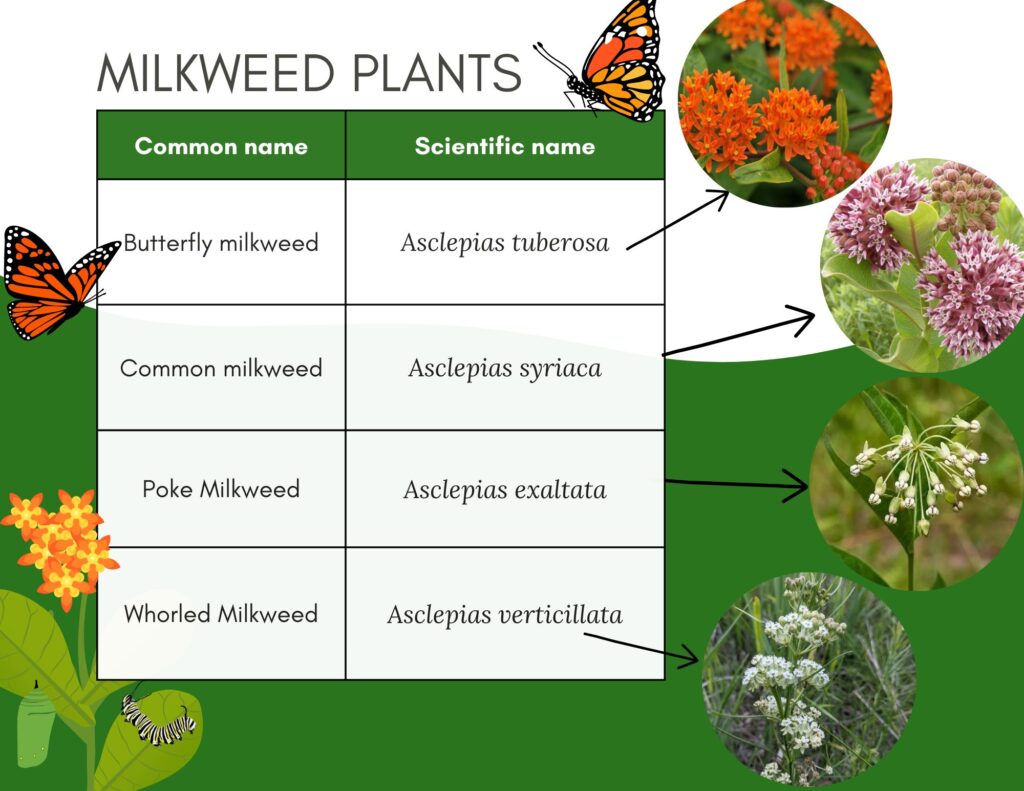
Figure 3. Milkweed species that support monarch populations in Indiana.
Milkweed plants free from toxic chemicals provide food for monarch caterpillars and a place for monarch butterflies to lay eggs and feed on nectar. Though the caterpillars are picky eaters, monarch butterflies are not. They can use nectar from a wide variety of plants, not just milkweeds. Consider adding a variety of flowering plants which bloom throughout the spring, summer, and early fall to your monarch garden. Providing nectar across these seasons ensures the adults have access to food while breeding, preparing to migrate, and during their migration. Hint – adults show a preference for orange and yellow blossoms! Here is a helpful table of additional pollinator plants that includes flowering color and season so you, too, can have a garden fit for a monarch.
- Figure 4. Monarch egg on milkweed. Photo by John Obermeyer, Purdue Extension Entomology.
- Figure 5. Monarch butterfly feeding on nectar. Photo by John Obermeyer, Purdue Extension Entomology.
Cover Photo. Monarch butterfly on common milkweed pods. Photo by John Obermeyer, Purdue Extension Entomology.
